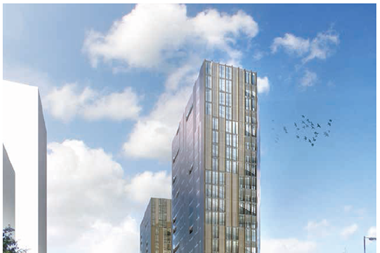I fear I’ve probably done to death the London buses analogy when discussing the private rented sector (PRS) in past columns.

So, for the sake of originality (and regional diversity), new initiatives emerging over the past few weeks have been more like the Edinburgh buses one normally observes snaking along Princes Street: flooding in from just about every direction and heading out to just about every conceivable destination.
While journalists employing language such as ‘floodgates’ waiting to be opened have been in the PRS sector for some years, it is only really now that the flow of purpose-built units has finally picked up beyond a trickle.
Announcements or trade press scoops have been coming in thick and fast the past month from developers, housing associations or funders offering a wide range of different models, either wanting to construct bona-fide build-to-rent projects or fund them. Or both.
Potentially among the most far-reaching is Legal & General Investment Management (L&G) last week teaming up with contractor Laing O’Rourke and Touchstone, the lettings management company owned by housing association Places for People. L&G had been talking for some years about leading the charge for investment-grade PRS in the UK, but until last week, actions had failed to live up to the words, other than a couple of mooted land deals.
This ‘one-stop shop’ would potentially allow the insurer to build 2,000 private rental homes a year on behalf of local authorities. The three groups have signed a strategic alliance whereby councils would lease sites to L&G, which would then fund Laing O’Rourke to build homes on them. These local authorities, in turn, lease the homes on those sites back from L&G, which is reportedly happy to accept sub-5% returns against long-term relatively stable rental streams. The housing would be managed by Touchstone. At the end of lease periods of 25-50 years, the councils would be able to buy each home back from L&G for a nominal £1 each.
The interesting features in this model include the potential for local authorities to become major providers of rental housing once more, albeit in this case private. It also provides an alternative customer for their land towards housebuilders, which are generally looking for margins of more than 20%, according to L&G. (The re-emergence of councils was underscored by Sigma Capital’s recent tie-up with Sheffield Housing Company for the provision of new PRS homes in the city.)
It is also interesting to see that L&G is teaming up with a contractor rather than a housebuilder. Other mainstream institutions have veered towards housebuilders, including Berkeley and Bovis, but the deals arrived at have resembled one-off bulk sales - not unlike those to housing associations - rather than being purpose built for the different end market that build-to-rent represents.
Crest Nicholson’s results in mid-June indicated a more bespoke approach. The South East-focused builder raised its overall volume targets mainly thanks to its PRS partnership with M&G. Like many developers exploring PRS, Crest has followed the trail to the US to explore its vast ‘multi-family’ rental sector. Crest’s model more closely replicates the US suburban ‘courtyard’ model than the urban: more low rise and clubhouse than high-rise ‘condos’, which has been the main focus so far in the UK.
Housing associations have also been queueing up to get in on the act - emboldened, no doubt, by eye-wateringly cheap debt. Housing association L&Q is to transfer £250m of its private rented stock into a new subsidiary, L&Q PRS (a more ‘it does what it says on the tin’ approach to branding than Thames Valley Housing’s Fizzy Living). L&Q’s current pipeline of 2,000 PRS homes will be transferred and up to 1,000 of these will be completed when the company is established in the autumn.
Your Housing Group has set up a for-profit commercial subsidiary called Hive as part of a large-scale expansion into the PRS market by the 33,000-home organisation.
Big UK developers are joining in the rush. British Land has submitted a planning application for the redevelopment of Crystal House in Ealing, to create its first bespoke private
rented scheme.
Rapidly cutting and pasting, there have also been further overseas groups appearing on the scene, generally in joint ventures and generally adding words such as ‘Living’ to the resultant company brand (a trend that goes back at least to Essential Living and US M3 Capital). Argent Related, a joint venture between the UK property group and Related Companies of the US, is reported to be agreeing a £230m forward-funding PRS deal at Galliard and Cain Hoy’s Millharbour project for around 400 flats.
Middle Eastern investor Apache Capital Partners has formed a £1bn joint venture with Moda Living to establish a regional PRS platform. The partnership aims initially to develop five schemes totalling 5,000 units, in Manchester, Birmingham, Liverpool and the South East.
Meanwhile, German-based real estate group Patrizia’s foray into the UK will centre on a 500-unit Manchester site… the list goes on.
So, whether bus or canal metaphors are employed, what now seems inevitable is the PRS sector is finally arriving in force and could fundamentally shake up the residential sector. A real sea change, you might say.
Alastair Stewart is building and property analyst at Progressive Equity Research






























No comments yet